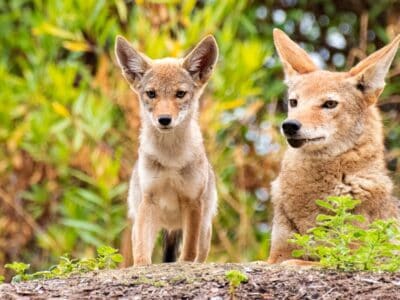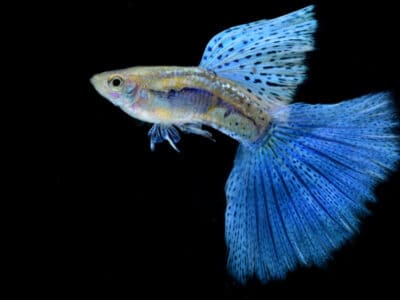Ural owl
Strix uralensis
The Ural owl can rotate its head up to 270 degrees
Advertisement
Ural owl Scientific Classification
- Kingdom
- Animalia
- Phylum
- Chordata
- Class
- Aves
- Order
- Strigiformes
- Family
- Strigidae
- Genus
- Strix
- Scientific Name
- Strix uralensis
Read our Complete Guide to Classification of Animals.
Ural owl Conservation Status
Ural owl Facts
- Prey
- Voles, shrews, rodents, birds, frogs, and insects
- Fun Fact
- The Ural owl can rotate its head up to 270 degrees
- Estimated Population Size
- Up to 1.2 million mature individuals
- Biggest Threat
- Habitat loss
- Most Distinctive Feature
- The large facial discs
- Wingspan
- 1.1-1.3m (43-53in)
- Incubation Period
- A month
- Habitat
- Conifer and mixed forests
- Predators
- Birds of prey and felines
- Diet
- Carnivore
- Type
- Bird
- Common Name
- Ural Owl
- Number Of Species
- 1
- Location
- Northern Eurasia
- Nesting Location
- Hollow tree cavities
- Age of Molting
- 1-2 months
View all of the Ural owl images!
The Ural owl can be found in some of the coldest climates in Eurasia.
This nocturnal bird is named for the Ural Mountains, generally considered to be a dividing line between Europe and Asia. However, its range is not limited to the Ural Mountains. This species is actually found all across northern Eurasia, using its thick feathers to stay warm in the extreme climate. This article will cover some interesting facts about the appearance, behavior, diet, and even symbolism of the Ural owl.
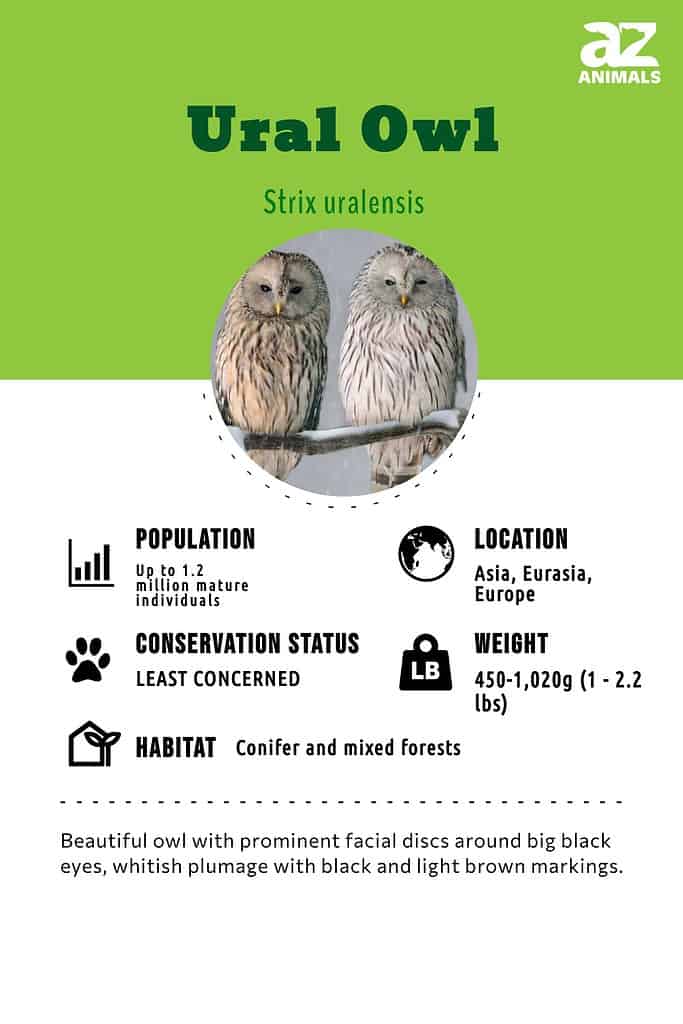
3 Amazing Facts About Ural Owls
- Ural owls have remarkable binocular vision that can see prey from long distances even in low-lighting conditions. Because their eyes are completely fixed into place, however, they have the ability to rotate the head up to 270 degrees to see around them. Blood pools up in their heads to prevent circulation from being cut off to the brain.
- One of the most interesting facts is that this species has some of the largest ears in relation to the body size of other owls. The uniquely shaped facial discs are used to funnel sounds toward its ears.
- Owls have three different eyelids to protect their eyes.
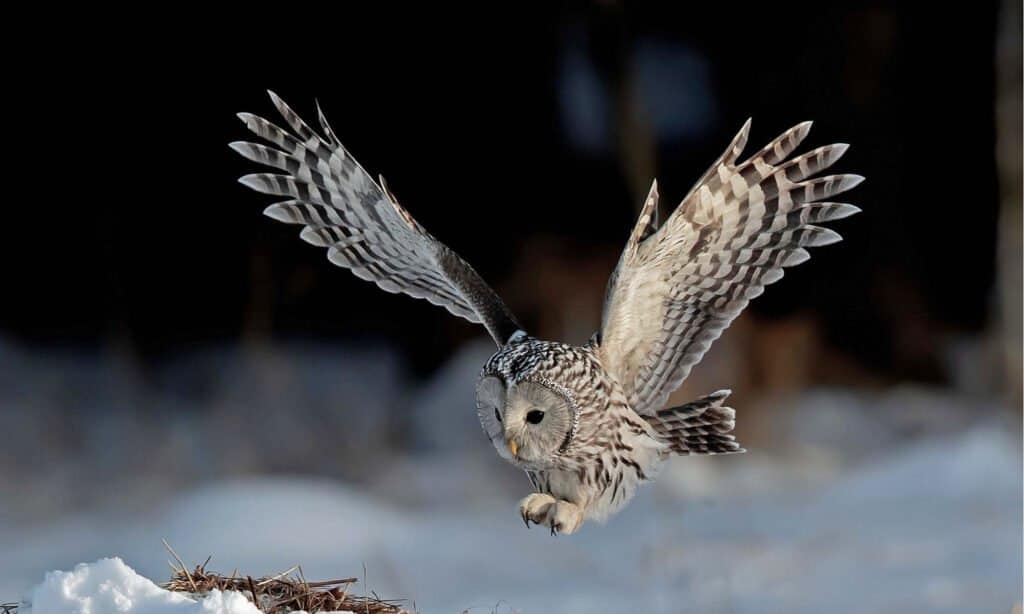
Ural owls thrive in cold northern forest habitats.
©Wang LiQiang/Shutterstock.com
Where to Find the Ural Owl
Despite the name, Ural owls are not limited to the Ural Mountain range. Instead, they are found all across northern Europe and Asia, from Germany in the west to the Pacific in the east. It is particularly common in Russia, Finland, Sweden, and Japan. These birds prefer to live in old conifers and mixed forest habitats with plenty of potential nesting sites.
Nests
Ural owls will establish a nest in old hollow tree trunks with twigs, feathers, fur, and other materials they can find. They will also move into abandoned twig nests and human-made nest boxes when given the opportunity.
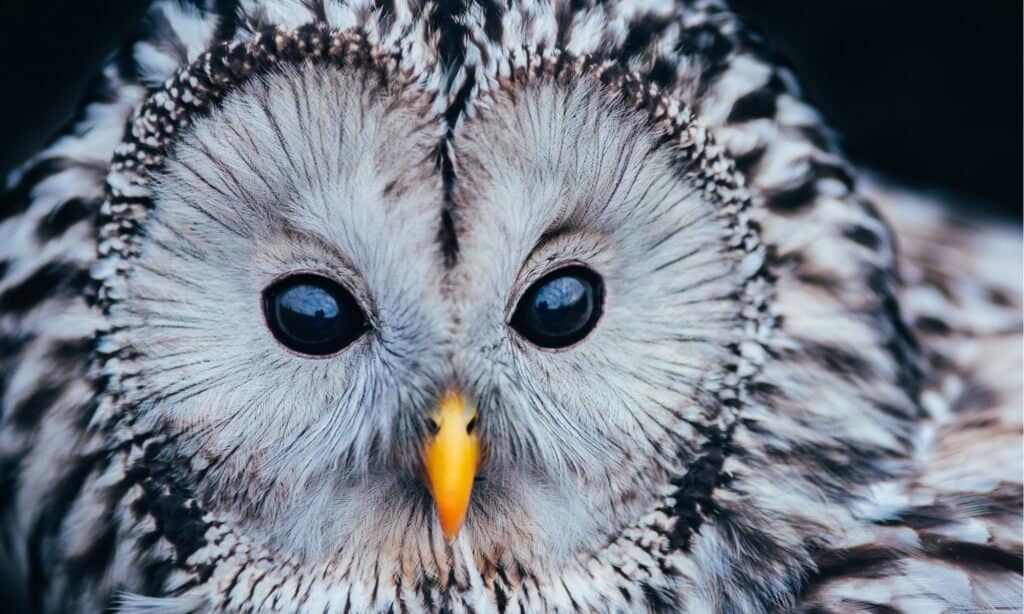
There are currently 15 subspecies of Ural owl recognized by taxonomists.
©Angyalosi Beata/Shutterstock.com
Scientific Name
The scientific name of the Ural owl is Strix uralensis. Strix is the Latin and Greek word for the owl. Uralensis is a Latinized form of the name Ural. This species is a member of the wood owl genus (meaning forest-dwelling owls). Around 15 subspecies are currently recognized by taxonomists.
Evolution
Fossil records show that owls were present as early as the Paleocene era 60-57 million years ago in the form of Berruornis and Ogygoptynx. They may have even been present earlier, at the extinction of non-avian dinosaurs – making them one of the oldest groups of land birds.
The Strigiformes expanded into ecological niches during the Paleogene while also evolving into their characteristic adaptations to many environments. By the early Neogene, all lineages had been displaced by other birds, leaving only barn owls and typical or true owls. The Ural owl is a true owl.
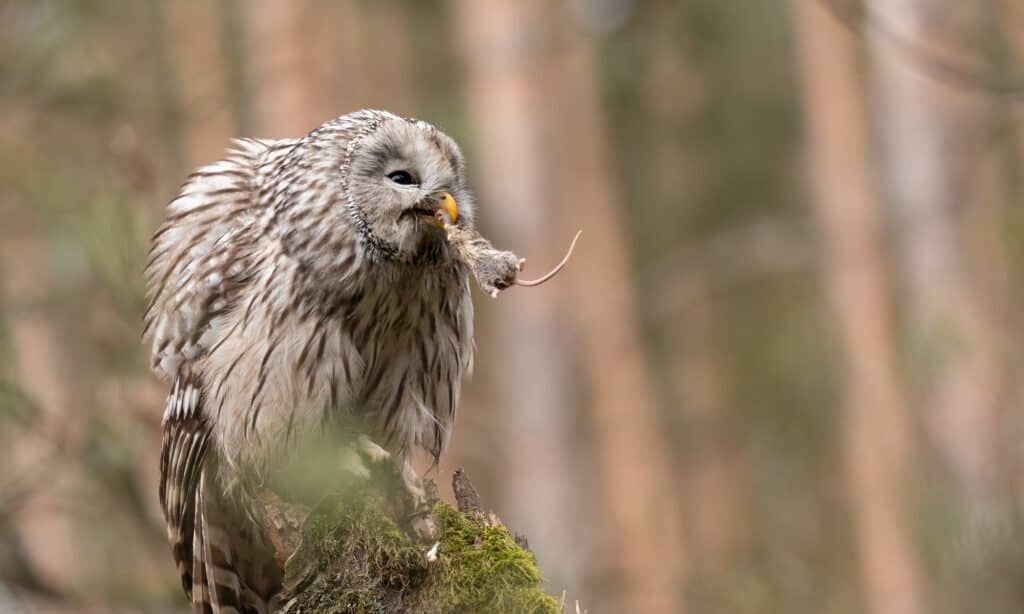
Ural owls are adept hunters with mice being a favorite meal.
©iStock.com/sduben
Species
There are currently 15 subspecies recognized by taxonomists including:
- Strix uranlensis uralensis – The nominate subspecies, found mostly in the Russian Far East and Siberia. This is the palest of the Ural owls with some Siberian owls being so whitiesh they are confused with Snowy Owls.
- S. u. davidi – Known as the Pere Davis owl, is is found in the mountains of central China.
- S. u. liturata – Found in northern Europe from Norway, Lapland and Sweden to Finland, the Baltic region, eastern Poland, eastern Alps, Carpathian mountains to the Volga.
- S. u. macroura – The largest Ural owl, this owl is found in the western Carpathians, Transylvanian Alps and West Balkans.
- S. u. yenisseensis – Found in the Central Siberian Plateau to northwestern Mongolia.
- S. u. nikolskii – Slightly smaller that the Ural Owls of Japan, these owls are found in Transbaikal north and east to Vitim, Sakhalin and south to the Korean peninsula.
- S. u. fuscescens – This Japanes owl is found from western an southern Honshu to Kyushu and is the smallest Ural owl.
- S. u. hondoensis – This owl is found throughout Hokkaido and central Honshu in Japan.
Size, Appearance, and Behavior
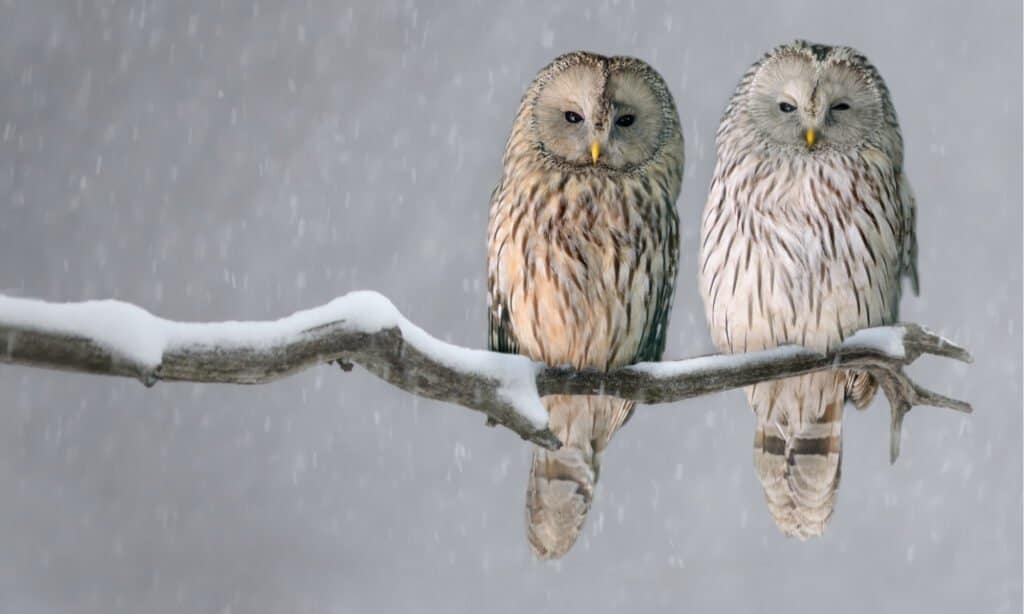
With its thick mat of feathers, the Ural owl is well-adapted to frigid northern climates.
©AlekseyKarpenko/Shutterstock.com
The Ural owl is a close relative of the tawny owl and great gray owl that people may be already familiar with. It is characterized by big black eyes, a long wedge-shaped tail, rounded wings, and very prominent facial discs around each eye. It also has stark white plumage with black and light brown markings all over the body. Dark streaks appear to run outward from the face and down the stomach and back, whereas bars are present on the wings. Adults can measure up to 2 feet tall with a wingspan of more than 4 feet long. Females are considered to be slightly larger than males, but otherwise, the two sexes look similar to each other.
With its thick mat of feathers, the Ural owl is well-adapted to the frigid northern climate of Eurasia. Instead of migrating south for the winter, it tends to remain in the same place all year long. Pairs will establish a defined territory and defend it with surprising force, sometimes even attacking humans in the process. This bird makes a deep hooting call which can be heard from up to 1.2 miles away. These hooting calls may have multiple purposes. They are used to claim territory, signal the presence of threats, and even communicate with their mate. Calls can be strung together to make songs as well. These nocturnal birds spend most of the night hunting and singing and the daytime sleeping.
Diet
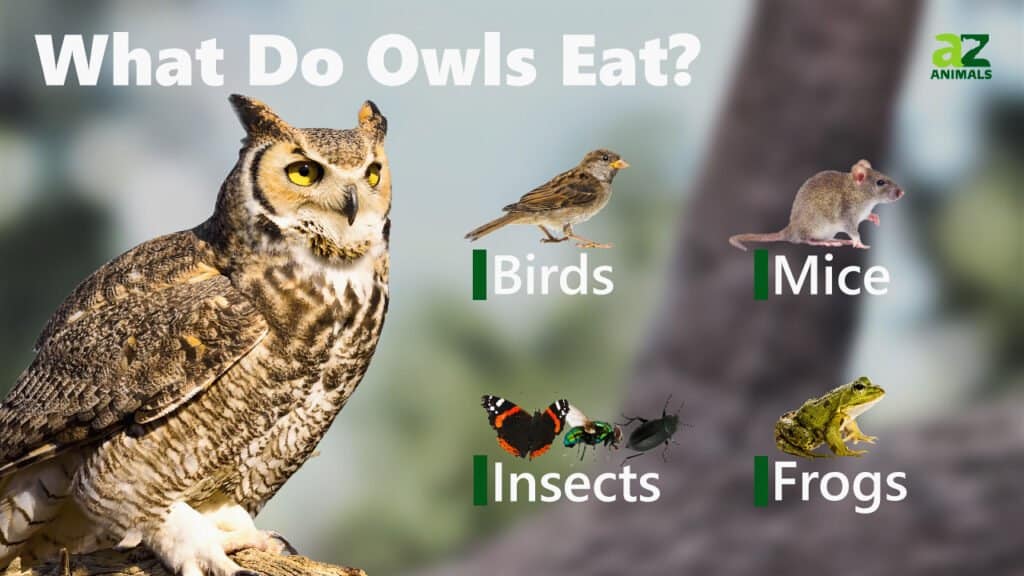
The Ural owl is a carnivorous species. It eats only meat and almost never feeds upon plant material. The Ural owl has a varied diet that consists of voles, shrews, rodents, birds, frogs, and insects. Jays, grouses, and wood pigeons are also part of their normal diet. As a nocturnal species, Ural owls do all their hunting at night. They stand on a tall perch and wait for the prey to appear in view before swooping down upon it.
Predators, Threats, and Conservation Status
According to the IUCN Red List, these owls are considered to be a species of the least concern. It is found most commonly in places with low human population density. It is therefore relatively unaffected by habitat and forest loss. However, population numbers have fallen in some parts of Central and Eastern Europe where its range is more likely to coincide with people.
What eats the Ural owl?
An adult Ural owl has few natural predators in the wild. The most dangerous animals it faces are perhaps birds of prey and large cats.
Reproduction, Young, and Molting
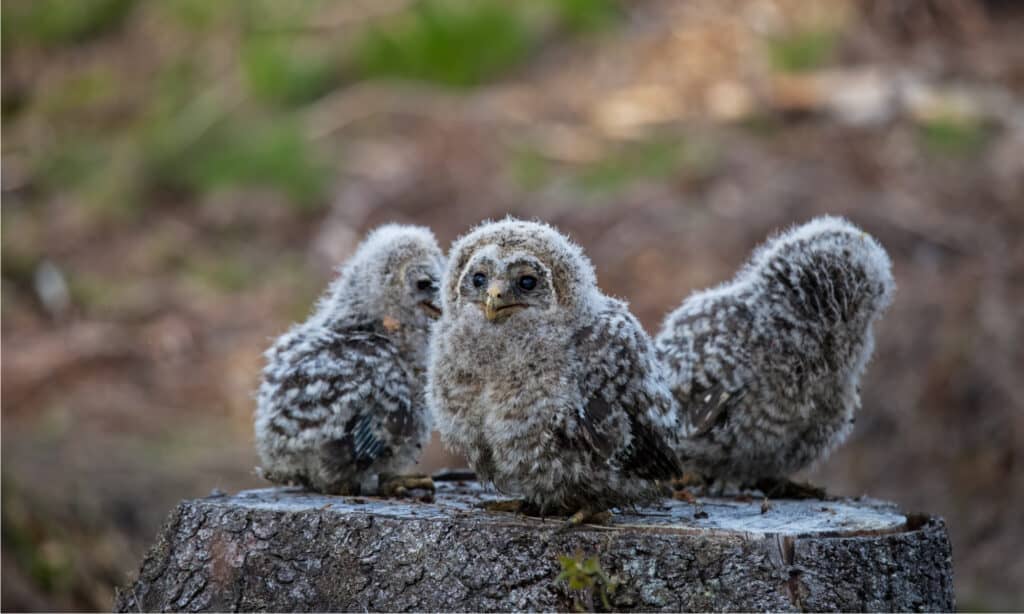
Ural owl chicks leave the nest after four week and become capable of flight a few weeks later.
©Lena Ostberg/Shutterstock.com
This owl is a monogamous species that tends to form a lifelong pair bond with its chosen mate. They spend each year maintaining the same territory and nest. The annual reproductive season will generally take place in spring to early summer. The female will lay a small clutch of up to six eggs (though two to four is the normal number). After an incubation period lasting for about a month, the chicks will hatch with a white down of feathers and receive plenty of care from their parents. They will first leave the nest at about four weeks old and become capable of flight a few weeks later. The Ural owl will tend to reach sexual maturity and grow their adult plumage about a year after gaining independence. It is estimated to have a maximum potential lifespan of around 24 years in the wild, but most don’t live much longer than 20 years.
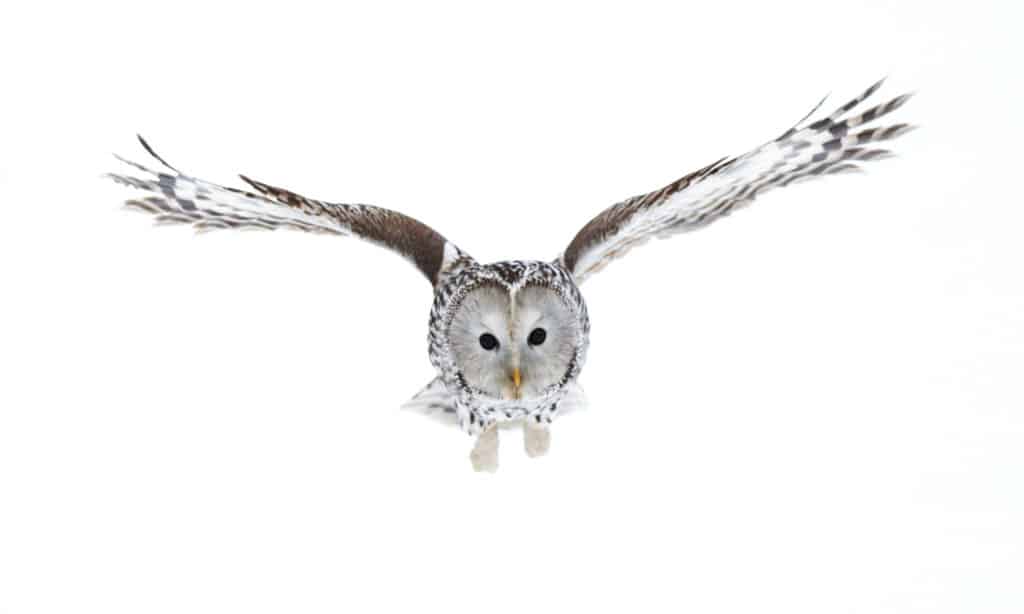
There are an estimated 1.2 million Ural Owls in the world.
©Kaido Karner/Shutterstock.com
Population
It’s estimated that the population numbers range anywhere between 350,000 and 1.2 million mature individuals in the wild. Their large range makes population numbers difficult to estimate with any degree of certainty. Nevertheless, this species appear to be very common throughout northern Eurasia. Although population numbers have fallen in some parts of Europe over the centuries, there have been serious efforts to reintroduce the species back into the former parts of its range.
View all 16 animals that start with UUral owl FAQs (Frequently Asked Questions)
Does the Ural owl migrate?
No, the Ural owl does not migrate at all. It has a defined home range that it maintains and defends throughout the entire year.
How many eggs does the Ural owl lay?
The Ural owl can lay as many as six eggs per clutch, but a more common number is two to four.
How fast does the Ural owl fly?
The exact flight speed of the Ural owl has never been properly established, but given how fast most other owls can fly (anywhere between 20 and 40 miles per hour), the Ural owl is likely to be similar.
What is the Ural owl’s wingspan?
The female owl has a wingspan about 49 inches long. The male has a slightly smaller wingspan of 45 inches long.
When do Ural owls leave the nest?
The chicks will leave the nest after about a month of hatching from the eggs. Until then, they receive plenty of food and protection from their parents.
What do Ural owls eat?
Ural owls eat small animals such as rodents, voles, insects, amphibians, and other birds.
Is the Ural owl endangered?
The Ural owl is actually a species of least concern, but population numbers may have fallen in certain countries such as Germany.
How big is a Ural owl?
The Ural owl normally stands about 20 to 24 inches tall.
What is the lifespan of the Ural owl?
This bird may have a lifespan of up to 24 years old.
What is the symbolism of a Ural owl?
In some cultures, they are seen as harbingers of death. In other cultures, they are associated with wisdom and knowledge. The symbolism is never a fixed thing.
Thank you for reading! Have some feedback for us? Contact the AZ Animals editorial team.
Sources
- Beauty Of Birds / Accessed February 28, 2022
- Zoo Leipzig / Accessed February 28, 2022
- Wildlife Park / Accessed February 28, 2022
- IUCN / Accessed February 28, 2022












